SAP S/4HANA Conversion Complication Factors
SAP S/4HANA Conversion Complication Factors
A look at a few common SAP S/4 HANA Conversion Complication Factors.
(This article is based on SAP S/4HANA 1809)
Abstract
Aim: To describe some of the important risk and complication factors when converting from SAP ECC to SAP S/4HANA.
SAP S/4HANA Conversion experts agree that SAP ECC system conversions pose the greatest risk, while there is a common misconception it is simply Data Migration and moving data from non-HANA databases to HANA databases. In some cases, Companies take the view that it is an unnecessary investment and activity. In a few cases, it could in fact be the opposite; Companies may spend more, assuming more risk than is necessary to perform SAP ECC system conversions. Complication factors and risk factors vary from system to System. Conversion Consultants, who have the experience necessary, greatly reduce conversion cost and risk as well as being able to help migrate data from ECC systems to SAP S/4 HANA in a non-disruptive manner.

Based on my SAP S/4 HANA Conversion and upgrade project experience, I would like to provide you with some of the most important factors that contribute to the risks associated with conversion projects. I will also share with you some challenges you may face with SAP S/4 HANA 1809 conversions. IT Departments should leverage a vendor Company, who has adequate knowledge in all of preparation and realization tasks and has experience Converting SAP ECC systems with multiple application components. This helps organizations to reduce risks and costs for the system conversion now and upgrade to newer versions of SAP S/4 HANA for the future. It will help reduce operating costs and prevent technological becoming obsolete.
Introduction
Organizations implement new business Software Applications to replace the functionality delivering of current legacy systems. Complications may arise when there is an attempt to do this transformation without proper planning and preparation. More often, the data structure of the present legacy system maybe different from the new application. The differences may not be limited to table names, field names or attributes, but sometimes database types may be different and diverse. To the business units, entire data being held in the current legacy system is critical for their business and decision making. To bring the data from the legacy system to the new system, Data Conversion and migration must take place in an efficient way. Very often Data Conversion and migration process tend to be risky as both the systems have different data models. Conversion consultants must analyze the data at source (Legacy) system and ensure all transactional data is complete and correct. They do this activity to check whether all documents in the source system are complete. Consultants use the result of these checks to correct inconsistent documents before starting the data migration. If data integrity checks were not strictly enforced, entire conversions and data migrations activities would fail. Therefore, it is important to have an experienced consultant on the conversion projects, who has a sound and methodological approach for conversion. This will help to address unpleasant surprises at later stages and resolve data migration issues in a quick and effective way.
SAP Customers might have invested massive amounts of time and money on their SAP ECC system (Source System). Moving to S/4 HANA is an inevitable as SAP ECC system ends by 2025. SAP ECC system Conversion has some challenges. If you can understand the challenges in SAP S/4 HANA Conversions, they can be avoided. In this paper I will write about some of them from my experience working on Conversion and Upgrade Projects, sharing the strategies that have worked for me. Below are some of the complication factors:
- Pre-Migration Impact Assessment & Readiness assessment
- ECC System Preparation for Conversion
- Profitability Analysis in ECC systems
- House banks Migration
- Material Ledger and Actual Costing
- Migration to New Asset Accounting
- Technical Check of Transactional Data & Enrichment of Data
- Cheap & Best Policy
1. a) Pre-Migration Impact Assessment & Readiness assessment
System Conversions are always a big challenge. To understand both technical and operational complexity, “Conversion impact assessments and Readiness assessments” are done in the SAP ECC system. This helps to determine the scope of the migration, to create or review configurations in the SAP ECC system (Source system) and to ensure appropriate software and hardware exists to support any conversion activity. It also helps to lock the scope of the project and to avoid scope creep and estimate downtime, based on the hardware and software of the existing system.
Impact analyses help in Plotting Smooth Paths for Conversion. Companies spend a lot of money on migrations/conversions, but up to 60 percent of migrated/converted systems fail to meet expectations often because of flaws in the conversion process. The team will have complete visibility of the source system and transaction data which can help identify potential problems. If Conversion teams start Conversion projects without a readiness assessment and impact analysis, it is risky and the project may go over budget and could exceed allotted times and schedules.
1. b) Readiness Assessment on ECC system
When you are planning for system conversions to SAP S/4 HANA, it would be ideal to do an SAP Readiness Check against SAP S/4 HANA to verify the different aspects of the existing SAP ECC system. Such as:
- Custom code impact
- SAP S/4 HANA sizing
- Replace existing transactions
- Relevant simplification items
- Business process analytics
The Readiness Check runs as of ERP 6.0 system. To run SAP Readiness Checks for SAP S/4 HANA, APIs are needed. To install these supporting APIs, implement the latest SAP Notes that are specified in relation to Readiness Assessments. The Readiness Assessment helps with the transformational process and identifies any potential challenges. Therefore, doing conversion/migration projects, without Readiness Assessments, can be risky.
You can visit the help portal for Readiness Assessments.
2. ECC System Preparation for Conversion
System Conversions may be hard but planning and preparing for it doesn’t have to be. The preparation phase is the most important area to success. Planning for Conversion tasks in each phase of Conversion projects is essential. It involves technical preparation, functional preparation as well as analyzing the data in the source system.
Technical consultants will verify system requirements for conversion, supported start releases, Unicode or non-Unicode, SAP ERP Java components, Data Volume, Custom code etc…
Basis Consultants will do the necessary preparation to execute a Maintenance Planner to do the conversion to SAP S/4 HANA, to verify Add-ons to your system, to verify Active business functions in your system and Industry solutions etc… The Basis Team will install the necessary Simplification item check relevant notes. The SI-Check is delivered with SAP Notes 2399707 and 2502552. SAP Note 2399707 delivers the new check report; SAP Note 2502552 delivers the check classes via transport-based correction instructions (TCI) and prerequisite notes.
All Functional consultants execute SI-Checks to identify the simplification items, relevant to the system, using transaction SE38. Report /SDF/RC_START_CHECK.
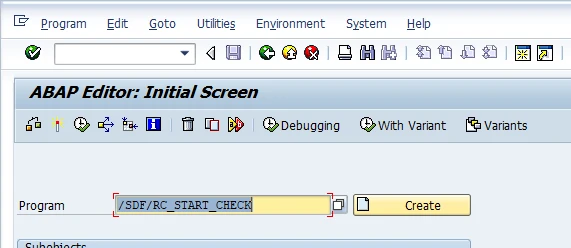

The SI check report returns a list of relevant and irrelevant simplification items. SAP recommends that you check every relevant simplification item for the impact.


Some simplification items have a consistency check. The consistency check identifies inconsistencies in the system that would be a problem during the SUM process. It also provides additional information on how to resolve the problem.
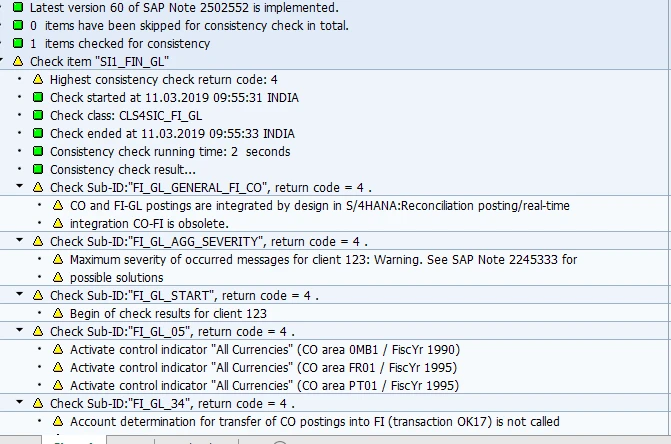
Some simplification items do not have a consistency check, but nevertheless are relevant. This means that from a technical perspective a conversion of your system is possible without any action from you, but there will be an impact and you should investigate it. For example:


The SI-Checks checks the ECC system for data consistency and effects on the data after the conversion. The severity of the resulting messages indicates whether there are no inconsistencies, warnings you should look at or inconsistencies you need to resolve. The results are provided as green, yellow, or red messages as shown in the screen prints above. You might encounter problems when migrating (and executing the SUM tool) if you do not address all of the warning and error messages. SUM execution delays and project get delayed and downtime may cross scheduled downtime.
3. Profitability Analysis in Source Systems (ECC systems):
When doing system conversions, we need to pay attention to CO-PA as it is somewhat of a complicated area. Some of the important points are specified below:
a) There are many CO-PA operating concerns in the system, for which account-based profitability was active before the conversion to SAP S/4 HANA. Therefore, there are many left outer joins to CE4xxxx tables in the (generated) ABAP managed database procedures. READ_ACDOCA_12X_MATCH and READ_ACDOCA_COEP_ONLY of class ZCL_FINS_MIG_UJ_HDB_GENERATED.

You may get an issue during the execution of migration activity MUJ "Data Migration into Unified Journal: Line Items". Refer SAP Note 2721709.
b) Check “type of Profitability Analysis” is activated in your system.

- If costing-based CO-PA is currently used, analyze what workarounds are being used to reconcile the profit and loss statement with costing-based CO-PA to determine whether these will be required in the future.
- If you currently work with costing-based CO-PA, you can continue to run both approaches in parallel, by making the appropriate settings in the controlling area. There is no direct migration from costing-based CO-PA to account-based CO-PA - you must activate Account based CO-PA manually and configure the same and generate during Year beginning.
- If you work with record type A: incoming sales orders, in costing-based CO-PA, these are covered in the predictive accounting approach in SAP S/4 HANA 1809.
- When reversing a logistical document, after Conversion to S/4 HANA, in the costing-based line items in table CE1XXXX, certain characteristics, which are filled from information in the logistical document, are initial whereas they are filled in the original line items. For example, characteristic KNDNR.
- For addition information, refer below to the following SAP notes 2176823 FAQ on CO-PA issues in S/4 HANA Finance (SFIN), 2439201 S/4 HANA Finance: Derivation logic when determining "attributed" profitability segments and.
- 2399030 Splitting the costs of goods sold in S/4 HANA.
4. House Banks Migration:
House banks Migration is a somewhat critical area in Conversion projects. You may get issues in this area so I would like to provide some of the issues I have encountered and resolved.
The below path is to be used to migrate existing house bank account data to the bank account master data in Bank Account Management. To migrate house bank accounts, you can transaction FCLM_BAM_MIGRATION or menu path.
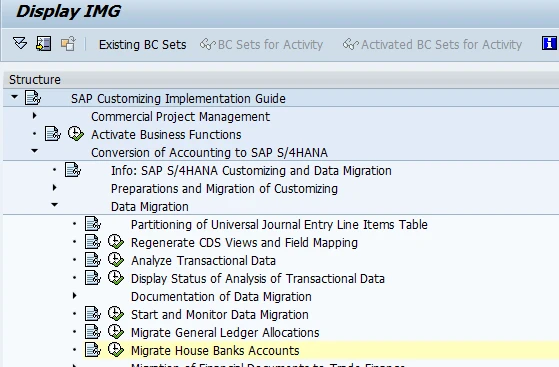
Before the migration, you must do the necessary configuration in the SPRO. See the below screen print:

Before you do a House bank migration, Check if your user ID has been assigned with the authorization object 'F_CLM_BAM'

When the migration has finished, if you encounter any issues, that may be caused by improper configuration in the above screen or lack of essential notes specified above, you can see log FCLM_BAM_MIGRATION.
Example Error: After migration, you get the message that the migration was successful. However, you cannot see any house bank account record in the table T012K.

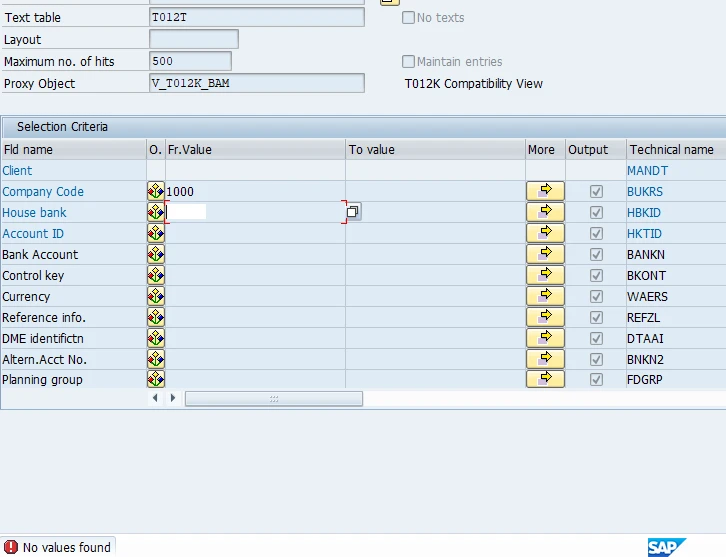
To resolve this, Table Redirection may be helpful.
- Go to APAP dictionary view by using transaction code SE11.
- Fill in T012K in the filed Database table.
- Choose the Display button. 2.4. Choose Utilities -> Runtime Object -> Display in the menu on the top.

In the header of the active runtime object section, make sure the field Physical Table has value V_T012K_BAM.

If there is no value in the field, you must redirect the table and generate CDS Views.
Another example is where, on occasion, migrations might be successful and you will be able see house bank accounts in the table T012K. However, when you try to do transactions using these house bank accounts, you receive an error message stating that "Entry xxx does not exist in T012K (check entry)".
To resolve this issue, check the version of the NetWeaver support package as follows:
- Log into the system.
- Run System -> Status... in the menu on the top.
- Choose the Other Kernal Info. button
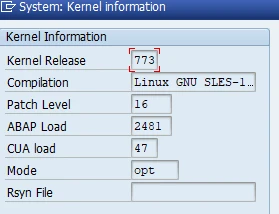
Check if the Kernal release is 773. Please upgrade Netweaver to at least Kernel release 742, support package 36.
5. Material Ledger / Actual Costing
Material Ledger Migration is a somewhat complicated area. If SAP’s Conversion guide, Simplification guide and Relevant SAP notes are not followed 100%, there is a high probability any conversion will fail!
The material ledger migration is needed when you are doing:
- Conversion from SAP ECC to SAP S/4 HANA (if you are using ML in ECC or even if you are not using ML in your existing system - ML migration steps are mandatory)
- Conversion from SAP Simple Finance 2.0 (1503) or 3.0 (1605) to SAP S/4 HANA
Material Ledger Migration is not needed when you are doing SAP ERP to SAP S/4 HANA Finance (Simple Finance) 1503 or 1605.
When we are converting an SAP ECC system to SAP S/4 HANA, on-premise edition 1809, even if you are not using Material Ledger, it will be activated during the conversion process.
Step 1:
Execute the following steps in the ECC system prior to the Conversion to SAP S/4 HANA (Preparation Phase).
- Firstly, apply the corrections that are provided in note 2240666: This note contains the ABAP check class that is called, by the ABAP program, FINS_MIG_PRECHECK_CUST_SETTNGS.
- Then apply the corrections of this note 2129306 to create the report.
- Afterwards start the program FINS_MIG_PRECHECK_CUST_SETTNGS to perform the checks.
In case the result list of this program contains error messages, you can find information about any root cause and potential solution in note 2245333.
The program FINS_MIG_PRECHECK_CUST_SETTNGS shall be started in all clients <> 000: In client 000 no checks will be performed, since the customizing content in client 000 will be overwritten anyway by the sFIN content during the upgrade to sFIN.
After your system is upgraded to S/4 HANA Finance or S/4 HANA, please check whether the corrections of note 2209641 are relevant, since the report can also be executed after the upgrade.

Step 2:
Verify if Material Ledger Actual Costing has been activated already in the system before the conversion to SAP S/4 HANA. (in the ECC system)
You can verify if Material Ledger Actual Costing is active for one or more plants via IMG / SAP Customizing Implementation Guide (transaction SPRO) or at table T001W, field MGVUPD. 'X'

With S/4 HANA the data model for material ledger has been changed a lot, especially when actual costing is active.
Before system conversion is started, all ML costing runs, no matter if actual costing (transaction CKMLCP) or alternative valuation run (transaction CKMLCPAVR) must be completed. For example, step 'post-closing' should be successfully executed. There should be no errors.
For all ML costing runs created in the source system, the post-closing step needs to be finished. It will not be possible to process costing runs created earlier in the new release.

No materials with status 'open'.
After system conversion to SAP S/4 HANA, it will not be possible to do any changes on costing runs created before the system conversion.
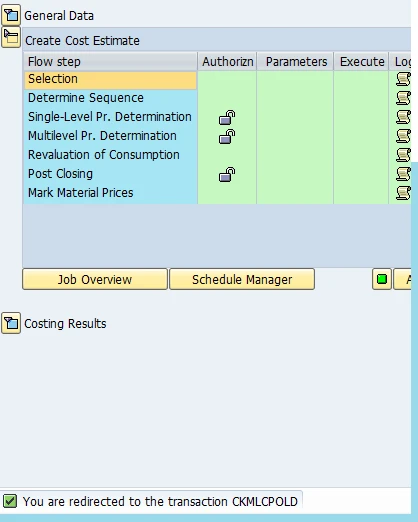
However, you can just display old CKMLCP runs although you cannot make any changes. After the migration of the material ledger data to S/4 HANA you want to display a run created before the migration, you can use transaction CKMLCPOLD or CKMLCPAVROLD. The create/ change functions are not active.
For all ML costing runs created in the start release, the Post Closing step needs to be finished. It will not be possible to process costing runs created earlier in the new release.
You can create new costing runs for previous periods or for the current period, after data conversion in the new system, but it is important to have no incomplete costing runs, where just some steps have been started and kept incomplete. You are also not allowed to change Material Ledger costing runs, nor to run steps of Material Ledger costing runs during the process of system conversion (before closing the cockpit). It is not possible to activate or deactivate Material Ledger Actual Costing during the process of system conversion for one or more plants.
Step 3:
Define the currency and valuation types that are relevant for Material Ledger using transaction OMX2.

Afterwards, assign this ML Type to your valuation area using transaction OMX3.
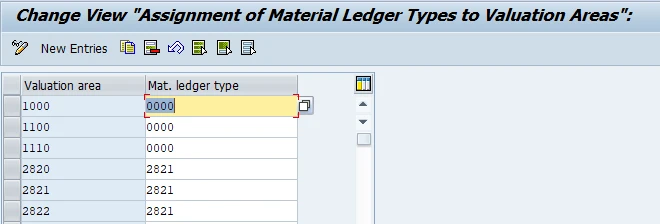
The following preparation steps are necessary in SAP S/4 HANA system:
Step 1:
Before starting material Ledger migration, in SAP S/4 HANA systems (after SUM tool) , implement the SAP notes that are associated in SAP note 2345739. This has SAP notes, which are relevant for the S/4 HANA 1809 Material Ledger migration. (SAP Note 2633352, 2657284, 2674766, 2673301, 2532117, 2661870, 2675774, 2706218, 2723152 etc...)
Step 2:
Preparation and Migration of Customizing for Material Ledger
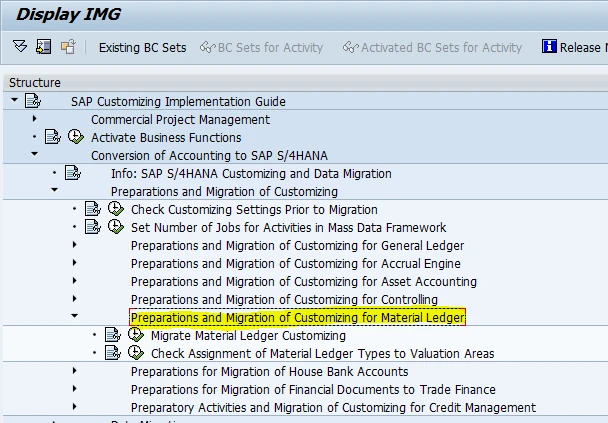
Migrate Material Ledger Customizing:
- This step is required if you are using SAP S/4 HANA Materials Management, even though you are doing a conversion from SAP Simple Finance to SAP S/4 HANA, or even if you are already using the material ledger in your source system (ECC).
Perform this activity ONLY after the following IMG activities are without errors

Firstly, execute as a test run - do not execute in the background. If any error messages are shown, contact SAP support.

Correct the errors before continuing then finally execute in update mode. If it executes without error, the customizing settings for the material ledger will be migrated to SAP S/4 HANA.
Once the Customizing settings for the material ledger are migrated, check the assignments of material ledger types to valuation areas and adapt them if necessary:
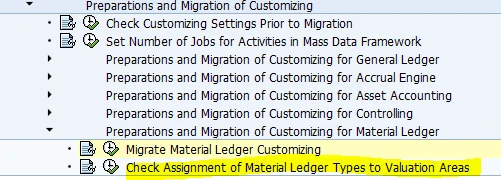
The above are the preparation steps for Material ledger in the SAP S/4 HANA system.
Material Ledger Migration (Data Migration)
Material Ledger Migration is part of Migration Monitor. Please note the following activities:
- Migrate Material Ledger Master Data
- Check Material Ledger Master Data
- Migrate Material Ledger Order History
- Check ML Production Order and Purchase Order History.
Below is the menu path for the Migration Monitor:
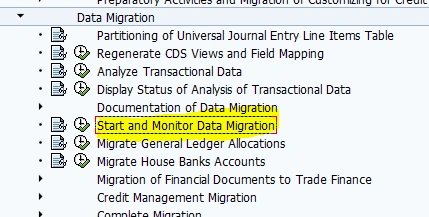
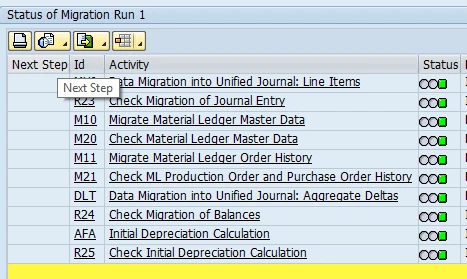
Steps M10, M20, M11 and M21 in the above screen prints. Please see above screen print for successful data migration (Green color).
M10: Migrate Material Ledger Master Data
This activity ensures ML is activated for all valuation areas and it creates material ledger master data (tables: CKMLHD, CKMLPR, CKMLPP and CKMLCR) in all material ledger currencies.
In addition, all existing inventory aggregate values (tables MBEW, EBEW, QBEW, OBEW) and their complete historic data (tables MBEWH EBEWH, QBEWH, OBEWH) are migrated into the new universal journal entry table.
The currency conversion in step M10 and M11 is done using standard exchange rate type 'M'.
Periods older than the last period of the previous year are only migrated in home currency. During migration, balance carryforward records (fields: BSTAT = ‘C’ and MIG_SOURCE = ‘N’) are created in ACDOCA.


If you are already using the material ledger, existing material ledger records (tables CKMLPP and CKMLCR) are transferred into ACDOCA with all existing currency information.
If Actual Costing is activated already in the source system (ECC), before the system conversion to SAP S/4 HANA tables MLDOC, MLDOCCCS, MLDOC_EXTRACT and MLDOCCCS_EXTRACT are filled automatically with data, during Migration Step M10, data related to ML Alternative Valuation Runs are not converted automatically during Migration Step M10.
M20:Check Material Ledger Master Data
This step checks the migrated data. For instance, existing values from the inventory and material ledger tables are compared with aggregation via table ACDOCA. If anything needs to be adjusted, you can reset the run and repeat it.
M11: Migrate Material Ledger Order History:
This task converts all existing purchase order history table records, and production order history table records, into the material ledger currencies using standard exchange rate type 'M'.
M21: Check ML Production Order and Purchase Order History :
This step verifies if all production and purchase order history records have been converted into the material ledger currencies or not.
The migration activities are parallelized using background jobs. Make sure enough background jobs are available.
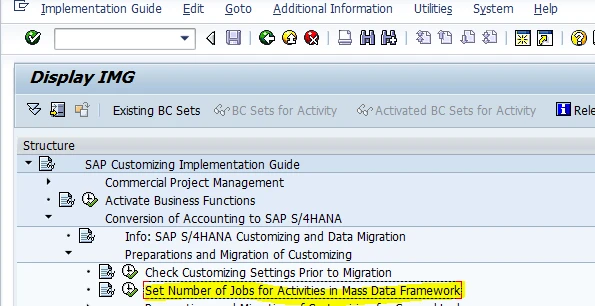
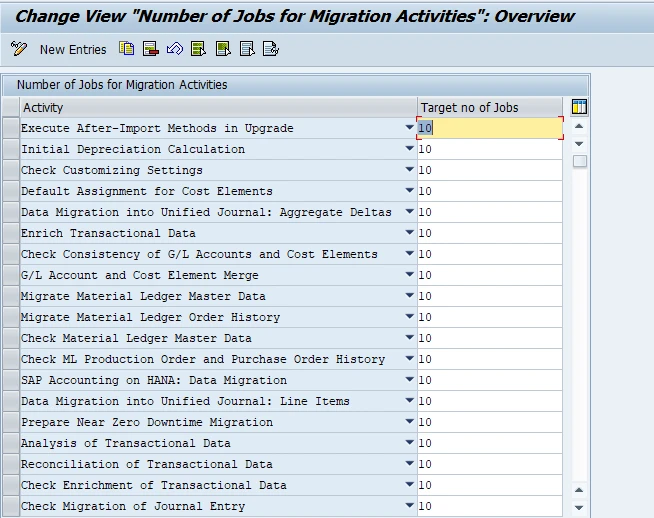
If you want to minimize the amount of data to be migrated, archive the data from Inventory valuation tables.
Additional Configuration After Conversion of SAP S/4 HANA
The Posting Logic of the Actual Costing in SAP S/4 HANA changed some areas. Some adjustments, therefore, are needed in Transaction OBYC.

Transaction PRL (Activity Price Differences):

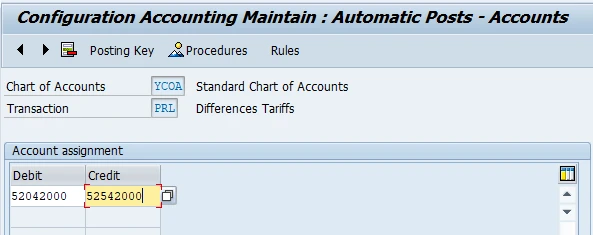

Transaction GBB/Account Modification AUI
This transaction was introduced with SAP S/4 HANA 1610. It is used for the offsetting posting of the cost center credit posting (Transaction/Account Modification GBB/AUI). Maintain the rules and posting key for transaction PRL. Then assign the accounts that will receive the activity price differences.
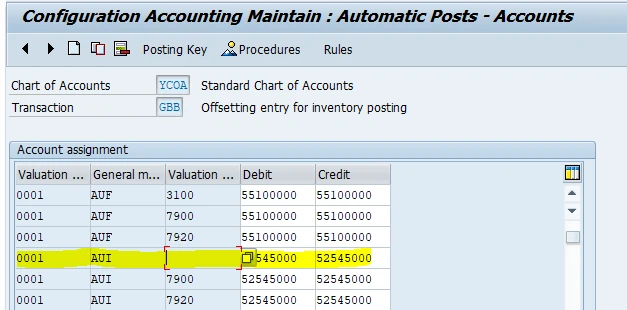
Transactions PRV and KDV

These transactions are obsolete with SAP S/4 HANA 1610 since the new Actual Costing no longer distinguishes between single-level and multilevel variances. Their account assignment entries may be removed.
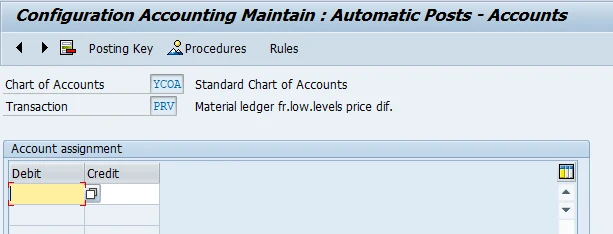
After the Conversion, we need to use transaction code CKM3PHOLD to see old documents of the material. You can use transaction CKM3 to analyze new documents that are created in S/4 HANA. After conversion, the Transaction code MMPI is not available to initialize the period for the Material Master record.
Important:
If transaction MMPV is executed by mistake for a future period (if the current Period is 1 of 2019, moved to 2 of 2019 incorrectly) as Material Ledger is active, it is not possible and not allowed to initialize the company code using transaction MMPI or report RMMMINIT. If you try, you will receive the error message MM016.

SAP Note 1082841 will help to prevent shifting to a future period by mistake.
If you have shifted to a future period by mistake, leave the periods as they are. You can continue with the material postings and use all functionality except price release for the period already opened in MM, and back postings to period X-1.
It should be no problem in ML as it is possible to post into “real” period (Period 1 of 2019). If you have moved to the second period of 2019, the first and second periods of 2019 open for postings so you may leave the system as it is. To do the period end closing in Material Ledger in period X-1, you can use the functionality of SAP Note 361236. If there is an issue with the price release of new materials, because the MM period currently is greater than Financial accounting period, you can implement modification SAP Note 551956.
As there is a new design of ML tables, Transaction CKM3 is created to read data from new tables. When you have done a conversion from SAP ECC to SAP S/4 HANA, there is chance to view the data.
Case 1 - If actual costing is active:
All materials with Price determination indicator 2 or 3 it is possible to show Price History view and Price determination view.
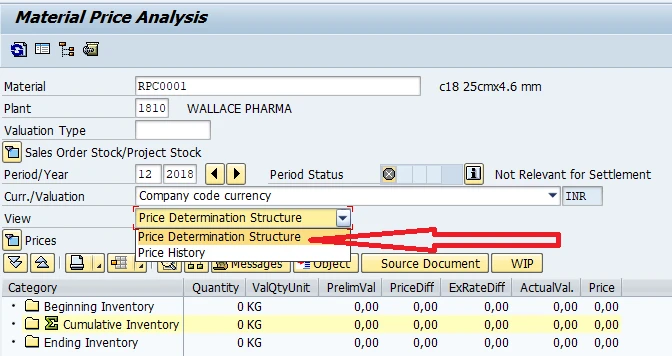
Case 2 - If actual costing is not active:
You will be able to display the Price History view only
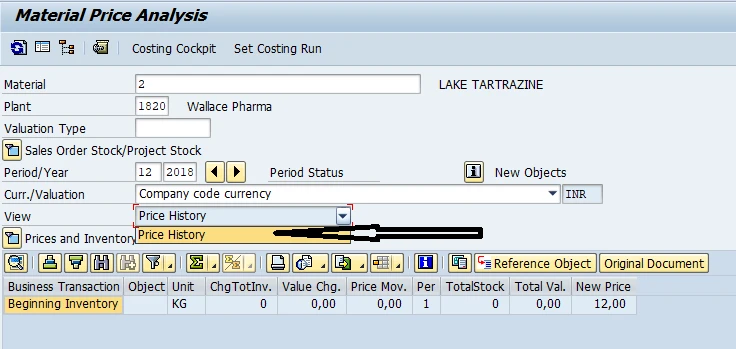
It would be ideal to use Price determination view for the materials with Price determination indicator 3. For those materials in Price determination indicator 2, it is better to view the results with Price History view.
Note: CKM3OLD will not display postings that are created after the Conversion. To see data older than the last period of the year before previous year, you can use transaction CKM3OLD.
6. Migration to New Asset Accounting:
During Conversion to SAP S/4 HANA 1809 Version, the Software Update Manager tool helps to check whether the prerequisites for a migration to SAP S/4 HANA are fulfilled for Asset Accounting.
If you are working on SAP S/4 HANA 1709, you have to use program RASFIN_MIGR_PRECHECK. The system will show error messages, if any, as below:

Once you adjust them, you must re-execute the same program to verify if the system meets the requirements for conversion for Asset Accounting:

Asset accounting is one of the complicated components in Conversion projects. Proper planning and preparation helps to reduce the number of errors and warning messages during the data migration.
For releases from SAP S/4 HANA 1809 onwards, use the Software Update Manager (SUM). For the SAP S/4 HANA 1809 release, implement the Simplification Item check Framework in your system. The first version of this framework is provided in SAP Note 2503309. Your ECC system is then checked in the precheck phase automatically.
If you want to perform the checks manually:
- Go to SE38, execute program /SDF/RC_START_CHECK
- ID SI2: FIN_AA provides the preliminary checks for Asset Accounting.

To see detailed check results, each check result has a check sub-ID. You can use the check sub-ID to find more information.

Follow the procedure described in the SAP note specified to correct the problem. Each error or warning message has an SAP note. That SAP note describes the problem-solving steps.
7. Technical Check of Transactional Data & Enrichment of Data
This is most important Conversion Activity. When migrating data to SAP S/4 HANA systems, Migration Monitor analyzes if all transactional data is complete or not. This comprises reconciliation of transactional data - steps RC1 & R21. This helps to enrich transaction data and documents. The enrichment is necessary for the merge of FI and CO documents within the migration of documents. The enrichment of data consists of the following activities in the transaction Start and Monitor Migration:
ENR Enrich Transactional Data & R22 Check Enrichment of Transactional Data
If there are any errors reported, we must address them before we move to next step.


8. Cheap & Best Policy:
Price and quality are two big factors when making a buying decision. I go for cheap when it comes to things I don’t really care about. Many companies compare prices from different vendors and make decisions based on the lowest price. Being economical is good as is saving money. Spending money wisely is good but always be cautious. Some things may be cheap now but may cost you more in the long run. It makes sense to me to spend more now for a better, longer-lasting experience. An experienced company may not be “the cheapest” option but they may be “the best”. Get the best! Spend now to save later. It's easy to get caught up in buying the cheapest service. Unfortunately, buying cheap may lead to spending more down the line on errors, maintenance, upkeep, or on future upgrades. My theory is, save money by investing in quality, so you don't run into unexplainable costs.
Conclusions
Be familiar with the Conversion Guide and Conversion framework suggested by SAP for SAP ECC system Conversions. There are different types of risks and complications involved in Conversion projects and data migrations. Following instructions in SAP Conversion and Simplification Guides (consultants must perform conversion activities correctly and sequentially) these risks and complications can be reduced. Due to the absence of resources, experienced conversion Consultants, time, budget etc... organizations may fail to perform conversion activity in an optimized way. Therefore, many functionalities may not work after the Conversion has taken place. Organizations convert/migrate their business software from one system to another to get the benefit of new features, functionalities and reporting capabilities.
During this migration, consultants and IT executives must explore Conversion frameworks, processes, activities, conversion challenges and their solutions by doing a test conversion. They should do more analysis, plan for testing of all transactions in a systematic way, even if you get a warning message during simplification item checks, don’t underestimate the size of the problem. Don’t plan for Production system conversions until enough tests have been conducted to prove correctness and accuracy. Conversion project timelines should be set to perform a full test conversion on the copy of Production system. If one test conversion does not produce correct results, then repeat the test again and again. Business users must test their scenarios and confirm before moving to conversion of the Production system. This helps to de-risk conversion projects and reduce the probability of failure.
It is usually assumed that the conversion team knows the existing ECC system. A pre-migration impact study & SAP ECC system readiness assessment needs to be done prior to the SAP S/4 HANA Conversion Project kick-off. Conversion/migration projects tend to be risky - they may create undue risk and stress if youfail to do a readiness assessment. The impact analysis and readiness assessment will expose unexpected scenarios and will help identify unexplainable problems for conversion. This helps accurately scope and de-risk conversion projects. It clears all assumptions and facts are known. This helps you to plan conversion activities effectively and provides tools, techniques and strategies that are needed.
Business data is a precious thing and must last longer than the systems - plan and prepare your conversion activity properly!
About the Author:
Dr. Ravi Surya Subrahmanyam is the Director of the SAP Practice for The Hackett group India Ltd. He received his Doctorate in Finance (PhD) from one India’s Top Universities! He is a Certified Application Professional - Financials in SAP S/4 HANA 1709 and is a SAP Education resource person for SAP India, SAP Education, SAP Indonesia Etc... You may reach him at sravi@answerthink.com or fico_rss@yahoo.com